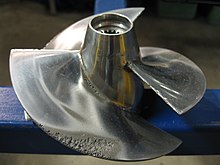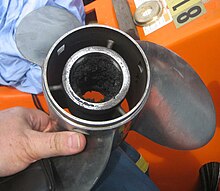Propeller
At about the same time, the French mathematician Alexis-Jean-Pierre Paucton suggested a water propulsion system based on the Archimedean screw.[7] One of the first practical and applied uses of a propeller was on a submarine dubbed Turtle which was designed in New Haven, Connecticut, in 1775 by Yale student and inventor David Bushnell, with the help of clock maker, engraver, and brass foundryman Isaac Doolittle.[8][9] On the night of September 6, 1776, Sergeant Ezra Lee piloted Turtle in an attack on HMS Eagle in New York Harbor.[14] In February 1800, Edward Shorter of London proposed using a similar propeller attached to a rod angled down temporarily deployed from the deck above the waterline and thus requiring no water seal, and intended only to assist becalmed sailing vessels.[15] In 1802, American lawyer and inventor John Stevens built a 25-foot (7.6 m) boat with a rotary steam engine coupled to a four-bladed propeller.The craft achieved a speed of 4 mph (6.4 km/h), but Stevens abandoned propellers due to the inherent danger in using the high-pressure steam engines.[16] John Patch, a mariner in Yarmouth, Nova Scotia developed a two-bladed, fan-shaped propeller in 1832 and publicly demonstrated it in 1833, propelling a row boat across Yarmouth Harbour and a small coastal schooner at Saint John, New Brunswick, but his patent application in the United States was rejected until 1849 because he was not an American citizen.[19]In 1835, two inventors in Britain, John Ericsson and Francis Pettit Smith, began working separately on the problem.[20] Smith quickly built a small model boat to test his invention, which was demonstrated first on a pond at his Hendon farm, and later at the Royal Adelaide Gallery of Practical Science in London, where it was seen by the Secretary of the Navy, Sir William Barrow.In the meantime, Ericsson built a 45-foot (14 m) screw-propelled steamboat, Francis B. Ogden in 1837, and demonstrated his boat on the River Thames to senior members of the British Admiralty, including Surveyor of the Navy Sir William Symonds.In spite of the boat achieving a speed of 10 miles an hour, comparable with that of existing paddle steamers, Symonds and his entourage were unimpressed.In September 1837, he took his small vessel (now fitted with an iron propeller of a single turn) to sea, steaming from Blackwall, London to Hythe, Kent, with stops at Ramsgate, Dover and Folkestone.On the way back to London on the 25th, Smith's craft was observed making headway in stormy seas by officers of the Royal Navy.This revived Admiralty's interest and Smith was encouraged to build a full size ship to more conclusively demonstrate the technology.[22] SS Archimedes was built in 1838 by Henry Wimshurst of London, as the world's first steamship[c] to be driven by a screw propeller.[27] The Archimedes also influenced the design of Isambard Kingdom Brunel's SS Great Britain in 1843, then the world's largest ship and the first screw-propelled steamship to cross the Atlantic Ocean in August 1845.[28] Understanding of low-speed propeller aerodynamics was complete by the 1920s, although increased power and smaller diameters added design constraints.[29] Alberto Santos Dumont, another early pioneer, applied the knowledge he gained from experiences with airships to make a propeller with a steel shaft and aluminium blades for his 14 bis biplane.Using Newton's laws of motion, one may usefully think of a propeller's forward thrust as being a reaction proportionate to the mass of fluid sent backward per time and the speed the propeller adds to that mass, and in practice there is more loss associated with producing a fast jet than with creating a heavier, slower jet.The pitch surface may be a true helicoid or one having a warp to provide a better match of angle of attack to the wake velocity over the blades.[32][33] A small number of ships use propellers with winglets similar to those on some airplane wings, reducing tip vortices and improving efficiency.[40] Twisted-toroid (ring-shaped) propellers, first invented over 120 years ago,[citation needed] replace the blades with a-circular rings.The design distributes vortices generated by the propeller across the entire shape, causing them to dissipate faster in the atmosphere.Under a damaging load the friction of the bushing in the hub is overcome and the rotating propeller slips on the shaft, preventing overloading of the engine's components.














Propeller (aeronautics)Propeller (disambiguation)Pratt & Whitney Canada PW100turbopropBombardier Q400aircraftthrustrotationalBernoulli's principlepropeller shaftstern scullingsingle bladeArchimedes' screwArchimedesirrigationEgyptiansbamboo-copterRobert HookeJames WattTurtleNew Haven, ConnecticutDavid BushnellIsaac DoolittleSaybrook, ConnecticutHMS EagleNew York HarborThomas JeffersonEdward ShorterDoncasterJohn StevensJosef ResselJohn PatchYarmouth, Nova ScotiaSaint John, New BrunswickJohn EricssonFrancis Pettit SmithSwedishHendonLondonhorsepowertons burthenPaddington CanalRiver ThamesBritish AdmiraltySurveyor of the NavySir William Symondspaddle steamersU.S. NavyUSS PrincetonSS ArchimedesBlackwall, LondonHythe, KentRamsgateFolkestoneSS Great BritainHenry WimshurstRoyal Navytug-of-warHMS RattlerHMS AlectoIsambard Kingdom BrunelAtlantic OceanHMS TerrorHMS ErebusFranklin's lost expeditionBaffin BayATR 72Wright brothersaerofoilwind tunnelaerodynamicsAlberto Santos Dumont14 bis biplaneundercamberedRMS OlympicPropeller theorymomentum theorymathematical modelW.J.M. RankineA.G. GreenhillR.E. FroudeNewton'sturbofanturbojetshelicoidalCavitationwater tunnelSchilling rudderlift coefficientvapor pressureshock wavescontrollable-pitch propellersfolding propellersmotorsailingLos Angeles-class submarineType 212 submarinescimitar bladesstealthywingletsastern propulsionmodular propellerVoith Schneider propellersRim-driven thrusterToroidal propellertoroidoutboardshear pinbushingtorquefrictioninterference fitsplinedflotsamyachtsbargesriver boatsnarrowboatstrailing edgehydroplaneshydrofoilScrew-propelled vehicleAdvance ratioAxial fan designPropeller walkAzimuth thrusterAzipod
